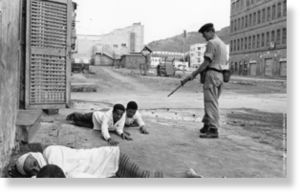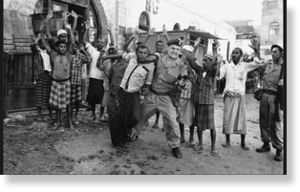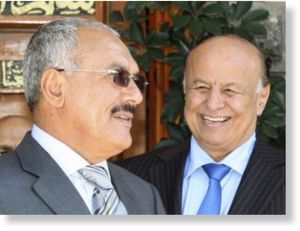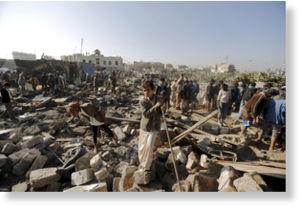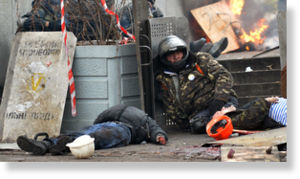US, British and Saudis thwart Freedom and Democracy in Yemen – again
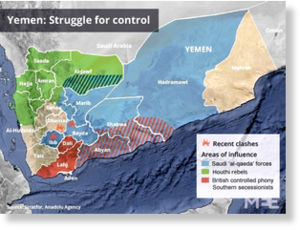 The 4 year-old ‘Houthi’ revolution in Yemen didn’t get a color name because it wasn’t backed by Western powers. In fact, it’s not called a revolution at all by Western governments or press, it’s called an “insurgency”, just like Iraq. And we all know that those fighting against the US military in Iraq were terrorists, right?
The 4 year-old ‘Houthi’ revolution in Yemen didn’t get a color name because it wasn’t backed by Western powers. In fact, it’s not called a revolution at all by Western governments or press, it’s called an “insurgency”, just like Iraq. And we all know that those fighting against the US military in Iraq were terrorists, right?
For those who aren’t up to date on the dominant lexicon: a popular rebellion by local people against a US-imposed ruler (like in Yemen) is called an ‘insurgency’ or ‘militant group’, run by ‘terrorists’. On the other hand, a limited rebellion that is provoked and stage-managed by US forces against a ruler the US wants to remove (like in Ukraine), is called a ‘revolution’ run by ‘freedom-loving people’.
Yemen under the jack-boot of the British
Yemen has historically been divided into two parts, north and south. The south was directly controlled by the British from 1839-1967 as part of their empire. After the first world war and the fall of the Ottoman empire, the north gained independence while the south remained a British colony.
The port city of Aden in the south was regarded as the key to the defense of British imperial interests in the Middle East, the Gulf and the Indian Ocean. As late as May 1956 a British junior minister, Lord Lloyd, stated that “for the foreseeable future it would not be reasonable or sensible or in the interests of the colony’s inhabitants to aspire to any aim beyond that of a considerable degree of internal self-government.”1 Naturally enough, Yemenis were less than enthusiastic about being indefinitely subservient to the British, who tended to provoke the odd genocide as part of their imperial conquests.
In response to an increasingly powerful trade union movement made up of the Arab working class who demanded better wages, living standards and infrastructure, the British attempted to consolidate their control in the South by establishing the Federation of South Arabia in 1959, a ramshackle affair made up of the various corrupt emirs, sheiks and sultans who were willing to side with the British against Yemeni nationalist aspirations in exchange for position and wealth.
British Petroleum had established an oil refinery in the south in 1954 and the wealth that this resource could and should have provided for the Yemeni people was instead shipped out to further British strategic interests elsewhere in the world, leaving much of the population impoverished. While the British governing elite have always (and still do) view all (or rather most) non-Western peoples as little more than howling savages, like so many other colonized nations, the Yemeni people had no trouble recognizing the injustice of the situation. Faced with an increasingly militant nationalist movement, the British reacted to the justified grievances of a mobilized civilian population in the only way they know how – subterfuge and violence.
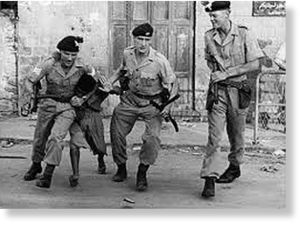
Search operations were carried out on a large scale in an attempt to restrict movement of men and weapons by the NLF. Inevitably, these searches, involving racist abuse and physical manhandling, further alienated the population. Stephen Harper, the Daily Express correspondent in Aden, wrote fondly of the troops that “there’s a lot of boot, gun-butt and fist thumping” but that this wasn’t brutality but rather “righteous anger” at the effrontery of the Yemeni belief that they had a right to rule themselves. An officer recalled how, when troops were banned from calling the Arabs ‘wog’, they wittily responded by calling them ‘gollies’ instead.
The counter-productive nature of such abuse always was (and still is) lost on the British political elite and military, and obviously did nothing to win the ‘hearts and minds’ of the Yemeni people in their rebellion against foreign domination.
Another tactic used by the British military (you may recognize this one) was the deployment of ‘Special Branch Sections’. These were eight to ten man mobile patrols with an officer in command. Dressed up as Arabs they carried out raids, searches and attacks against British and Yemeni civilian and military targets that could then be blamed on the insurgents in an effort to justify the British oppression. The SAS in its first official deployment against urban guerrillas was also deployed in ‘Keeni Meeni’ squads (a Swahili term appropriately meaning ‘slithering snakes’). ‘Keeni Meeni’ members were SAS men thought most likely to be able to pass for Arabs.5
Without intelligence sources within the local Arab population, British military leaders settled on the inspired idea that torture of prisoners was the next best thing. This mainly involved beatings of one form or another but also sensory deprivation techniques that would later be used in the 30-year dirty war in Northern Ireland and more recently in Iraq and Afghanistan.
At the time, allegations of torture and brutality were made in the British press against the Argyll and Sutherland Highlanders, an infantry regiment of the British Army. The conviction of members of this regiment in 1981 for the brutal murder of two Catholic farmers in Northern Ireland in 1972 led to revelations about events in Yemen. The Glasgow Sunday Mail reported that it had:
“conducted a careful and comprehensive investigation including the sworn statements of a dozen soldiers and officers detailing murder and robbery of local Arabs. A single soldier admitted shooting dead five unarmed Arab civilians in different incidents. Several others said they used morphine injections to kill captives. Others claimed to be witnesses to the bayoneting to death of a Arab teenager whose only crime was to be found in a cafe after curfew.“6
In 1962 the Iman of North Yemen was overthrown in a coup. He had been in power only a week after succeeding his father whose corrupt reign had left 80% of the population in poverty (he was supported by the British and the Saudis). The coup was, therefore, not surprising. A new Yemen Arab Republic was established and supported by the pan-Arabist Egyptian president Nasser. The royalists loyal to the ousted Imam began an insurgency supported by the Saudi and Jordanian royals and a civil war ensued for 8 years with the covert aid of the the British and Israeli governments and militaries.7
British involvement was motivated by a desire to ensure that corrupt tin pot dictators ruled in both North and South Yemen, the kind of people who would pose no threat to British control over the strategically important South Yemen. Israeli involvement was for much the same reasons, except that Israel has always wanted as many corrupt and corruptible tin pot dictators in the Middle East as possible to ensure its own hegemony. Egyptian PM Nasser was motivated to help the rebels because of his long-standing anti-imperialist aim to unite the Arab peoples. And the Saudis were motivated (as they are today) by a desire to ensure that real democracy did not break out in Yemen and infect Saudi Arabia, leading to the end of their rule. These competing motivations accounts for 200,000 dead by the end of the war.
For their part, the British were well aware of the nature of the regime they were supporting. British Foreign Secretary at the time, Alec Douglas-Home, admitted that the republicans held more “attraction for the average Yemeni […] than the Imams“, and this would “cause us a great deal of trouble“. Basically, the will of the people of North Yemen for real democracy and better living standards was a problem for the British government because the British government wanted to support the corrupt Imams.
Even as British SAS mercenaries were involved in attacking both the rebels and the Egyptian military, the British Prime Minister’s office noted that Egyptian President Nasser had been:
‘… able to capture most of the dynamic and modern forces in the area while we have been left, by our own choice, backing the forces which are not merely reactionary (that would not matter so much) but shifty, unreliable and treacherous’.
British Prime Minister Harold Macmillan himself admitted that it was:
“repugnant to political equity and prudence alike that we should so often appear to be supporting out-of-date and despotic regimes and to be opposing the growth of modern and more democratic forms of government“.
The war ended in 1968 after Egypt’s defeat in the 1967 war with Israel, and Saudi Arabia ended its support for the royalists. The North was reborn as the nation of ‘North Yemen’. The British pulled out of the South in 1967 although they continued to wage a covert war against socialist groups there to ensure British interests were protected.8
Unified Yemen 1990-2015
Skipping by a few brief “civil wars”, in 1994 north and south Yemen were united into one country and in 1999 the first directly elected president was Ali Abdullah Saleh. Saleh had previously president of North Yemen and the unified Yemen from 1994. He served two terms during which he was accused of corruption and mismanagement. Saleh ruled Yemen in a power-sharing deal with two others: major general Ali Mohsen al-Ahmar, who controlled the largest share of the army; and sheikh Abdullah al-Ahmar, figurehead of the Islamist Islah party. Ahmar was Saudi Arabia’s chosen broker of “transnational patronage payments” to various political players. Yep, the phony Arab Kings in their palaces in Saudi openly give large sums of money to all competing factions in Yemen in an effort to influence the country’s course. If only Western politicians could be so honestly corrupt, eh?
Under Saleh, Yemen continued to be one of the world’s poorest countries with widespread unemployment and persistent inflation and where the profits from $billions in oil revenues end up in the coffers of British, French and US oil corporations and the pockets of Saleh and his cronies. Meanwhile, 40% of Yemen’s population lives on less than $2 per day. In 2011, as Saleh was in the process of trying to make himself president for life, the ‘Arab Spring’ broke out in Tunisia and swept the Arab world, including Yemen. Throughout 2011 protests against Saleh swept the country and were responded to in much the same way the British government responded to similar protests in the 1960s in South Yemen. In March 2011 for example, at least 50 protestors were killed by snipers in the capital of Sanaa.
In April 2011 Saleh agreed to step down, but quickly back-tracked leading to more protests and an assassination attempt. This apparently convinced him that it would be better to resign and he did so on June 4th but not before appointing his Vice President Abd Rabbuh Mansur Hadi as his successor. It wasn’t until Dec. 2011 that actual power was transferred.
As you may have gathered from recent events in Yemen, President Hadi hasn’t fared much better than Saleh, that’s because he, like Saleh, is largely controlled by Western governments and their corporations and the ever-watchful and paranoid Saudis. The Houthis are a 100,000+ strong Shia Muslim group from Northern Yemen. They take their name from Hussein Badreddin al-Houthi who led a rebellion against the US-backed Saleh regime in 2004. Since then, the Houthis and their supporters have repeatedly campaigned and fought for the removal of quisling administrations in Yemen and during the ‘Yemen spring’ of 2011 they declared an independent state in the north.
ISIS and al-Qaeda: proxy forces for the Empire
Last August, the Houthis began a series of demonstrations in the capital Sana’a against increased fuel prices in their oil rich nation. During the protests the Houthis fought with government forces and also “al-Qaeda in the Arabian Peninsula”. AQAP is, of course, Saudi Arabia’s mercenaries masquerading as the world’s most wanted terrorists.
On September 21st 2014, the Houthis took control of Sana’a and forced the Prime Minister to resign. President Hadi offered a power-sharing agreement to the Houthis and General People’s Congress (a Yemeni political party that promotes pan-Arab nationalism) but both rejected it based on the fact that it was a case of ‘meet the new boss, same as the old boss”. Hadi went ahead and swore in the new government on November 9th anyway.
By January this year, the Houthis had seized the presidential palace and Hadi’s private residence, forcing him to flee to the south to Aden. The Houthis then officially took control of the Yemeni government on February 6th, dissolving parliament and declaring its Revolutionary Committee to be the acting authority in Yemen. When Yemeni air force jets bombed Hadi’s palace in Aden last week, he ‘went to ground’ only to pop up…in Saudi Arabia of course! You’ll be hard pressed to find reports of this incident in the Western media. Why? Because if this rebellion is merely the work of a small ‘faction’, how to explain that it appears to have the support of the Yemeni air force leadership? Clearly we are not being told the truth about the situation by the Western press.
During this time, those erstwhile defenders of Western corporations and destroyers of freedom and democracy everywhere – ‘al-qaeda’ ‘AQAP’ ‘IS’ ‘ISIS’ etc. etc., who had declared war on the Houthis (naturally) decided to bomb two Shia mosques in Sanaa that were packed with Houthis. 142 were killed ad at least 350 were injured. You get the picture. When the Saudi-Israel-US axis can’t fight openly, they use their proxies, who are also “sworn enemies” of the West, to do the job for them. The benefit of this tactic is that the axis can then justify bombing their real enemy – the rebel Houthis – and all other actual freedom-loving people of Yemen – under the guise of waging a ‘war on terror’. Easy!
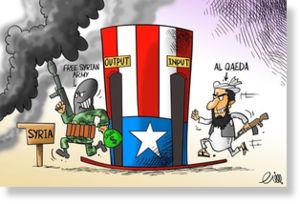 Interestingly, a spokesman for the Houthi group accused Yemen’s President Hadi of arming members of al-Qaeda in the east of the country in order to create a new security crisis. In a televised speech on March 22, Houthi leader, Abdul Malik al-Houthi accused US and Israel of supporting the mosque attacks. He also blamed regional Arab states for financing terrorist groups operating inside Yemen. Now those ‘regional Arab states’ are engaged in a ‘coalition’ that is bombing Houthi positions.
Interestingly, a spokesman for the Houthi group accused Yemen’s President Hadi of arming members of al-Qaeda in the east of the country in order to create a new security crisis. In a televised speech on March 22, Houthi leader, Abdul Malik al-Houthi accused US and Israel of supporting the mosque attacks. He also blamed regional Arab states for financing terrorist groups operating inside Yemen. Now those ‘regional Arab states’ are engaged in a ‘coalition’ that is bombing Houthi positions.If you watch the Western media reporting on these events, you’ll hear repeated references to “al qaida in the Arabian penninsula” and fears about them “launching attacks against the West”. This is obviously unadulterated bullshit designed to justify the US-backed Saudi attacks on the Houthis and others who want rid of the corrupt US/Saudi-imposed regime and a restructuring of Yemeni society. If it wasn’t already obvious that this is a US attack on Yemen by proxy, two US warships in the Gulf of Aden are now said to be “ready to respond in Yemen” with US logistical and intelligence support and a “Joint Planning Cell with Saudi Arabia” set up to coordinate efforts with the Saudis. That’s right! Go get ’em Uncle Sam! Send in the Tomahawk cruise missiles laden with “freedom and democracy” to take out those rebels fighting for, well, freedom and democracy! (just not the right kind).
‘Civil Society’ Comes to Yemen
Those that have read my articles on last year’s Euromaidan in Kiev that led to a coup d’etat will know that various US ‘aid’ agencies played a major role in organising that particular ‘revolution’. It should come as no surprise that the same agencies have been hard at work in Yemen for several years. Apparently the back up plan (if bombing the Houthis doesn’t work) is to turn the clock back by creating a movement for secession in the south of Yemen. USAID, for one example, has funded a $3.58 million project called “Promoting Youth for Civic Engagement (PYCE) to train Aden youth in PACA [political activity training], first aid, self-defense, photography, calligraphy and various other topics,” including “media skills.” The project’s cover is as a “youth sports program,” it focuses on self-defense, first aid, photography and calligraphy (making protest signs) classes. All the ingredients necessary for a nice US-backed ‘popular revolution’. Both the Arab Gulf Monarchies and Western powers are determined to hold on to the strategically important south of Yemen. The only scenario where they would be willing to allow the Houthis some level of independence is in a small part of the north in the context of a breakaway south which would remain under the control of the West.
It’s worth noting here, if only to add one more example to the long list, the hypocrisy displayed by Western powers. When former Ukrainian president Yanukovych was ousted last year in a violent Western-backed coup and forced to flee to Russia, he was labeled corrupt and illegitimate by Western governments. Yet when the corrupt President Hadi was ousted in a non-US-backed coup in Yemen last month, and forced to flee to the unimaginably corrupt Saudi Arabia, he remain the “legitimate president of Yemen” in the eyes of the West and full support has been given to a Saudi-led bombing campaign against the people who ousted him. ‘Double standards’ just doesn’t quite define it.
But the really big question here is: is this the ‘big one’? With 10 Arab states all playing a part in this game of “bomb democracy out of the Middle East”; the Saudis ready to send 150,000 troops into Yemen, and Egypt happy to join the fray; Iran supporting the Houthis; US war ships stationed off Yemen; Russia and Iran not just suggesting but “demanding” that the bombing stops; and it all happening at a time when a US “nuclear deal” with Iran is supposedly about to emerge while Israel is chomping at the bit to bomb Iran…could this be the fabled spark that has long been prophesied to ignite the ‘tinder box’ that the West has deliberately made of the Middle East?
Notes:
- Glen Balfour-Paul, The End of Empire in the Middle East, Cambridge 1991, p.67
- Joseph Kostiner, The Struggle for South Yemen, London 1984, p. 53
- John Newsinger, British Counter-Insurgency, Palgrave 2002, p. 117
- Stephen Harper, Last Sunset, London 1978, p. 85
- Tony Geraghty, Who Dares Wins, London 1992, p. 400-403
- David Ledger, Shifting Sands: British in South Arabia 1981, Peninsular
- Mark Curtis, Unpeople: Britain’s Secret Human Rights Abuses: The covert war in Yemen, 1962-70
- ibid
